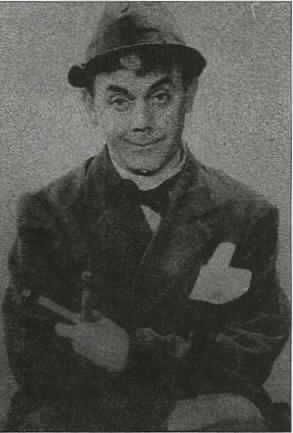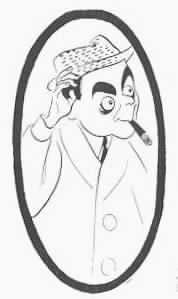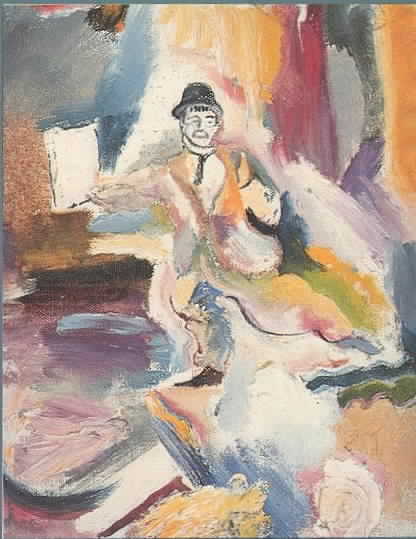
|
John T. Ordeman
Two Portraits by E. E. Cummings: Jimmy Savo in
Poem and Painting
[Spring 6 (1997): 49-54]
"Burlesque appeals to me," wrote E. E. Cummings; "I’ve seen in the
past thirty years of my proletarian life, a lot of burlesque shows (and I
hope to see a lot more)." [1] Burlesque in the first
half of this century was not merely a parade of strippers and a chorus line
of 20—Girls—20; and it was not the girls that drew young Cummings to the
Howard Atheneum in Boston: "Less extraordinary than the Howard’s filth was
the ugliness of the girls—but not [end page 49] much less . . . they’d
make your eyes wince." [2] It was the burlesque comedians’
bawdy skits and comic dances and songs that drew Cummings to the Old Howard
and subsequently to the National Winter Gardens in New York.
Jimmy Savo
Photographer unknown
|
| The top banana at the "gaudy and tawdry" Winter Garden, a man Cummings
referred to as "one of the two very great actors in America," was the "super-Semitic,
black-derbied, misfit-clothed, keen-eyed but ever-imposed-upon" [3] Jack Shargel, who was also the subject of a Cummings
ink drawing, a fine example of Cummings’ talent as a draughtsman and a caricaturist.
Jack Shargel Ink drawing
by E. E. Cummings
|

|

Jimmy Savo, Ink drawing by Al Hirschfield |
Charlie Chaplin, who began his career on the stages of British music
halls and American vaudeville theaters, was Cummings’ nominee as the other
great actor in America. Chaplin was also caricaturized by the artist in
an ink sketch that is certainly
Cummings’ most well-known and most accomplished drawing.
A third stage comic admired by Cummings, though not placed by him
in the class with Shargel and Chaplin, was Jimmy Savo, whom he portrayed both
in his poem "so little he is" and in an oil painting, "Jimmy Savo Performing"
(shown later).
Savo, an Italian-American born in New York City in 1896, advertised
his talents at the age of 14 in Variety, claiming he could "juggle
everything from a feather to an automobile." [4]
Subsequently he was featured in vaudeville, [end page 50] in revues,
on Broadway stages, and in Hollywood films as a dancer, singer, mime, and
comic actor.
|
A review of "Once in a Blue Moon," a 1936 Hollywood movie, described the
performance of "that exquisite and adorable clown Jimmy Savo" as "lovely,
fragile and infinitely touching." [5] "The gleaming
eyes, the shiny, bulging cheeks, the cheerful mouth, the battered derby,
the clerical collar still represent the apotheosis of Jimmy," wrote Brooks
Atkinson in a review [end page 51] of Savo’s 1940 one-man show, Mum’s
the Word. [6] Burton Rascoe, reviewing the 1943
Broadway comedy What’s Up, wrote that Savo had "the appeal of one’s
idea of a leprechaun . . . but also has an extraordinary sense of wacky satire
in pantomime." Rascoe also wrote, "I’ve heard it said that Charlie Chaplin
once stated that Mr. Savo is the greatest pantomime artist living." [7] If Chaplin actually made such a statement, he was
perhaps being overly modest and generous; but certainly Cummings was not alone
in is appreciation of the multifaceted comic genius of Jimmy Savo.
Although Savo was a popular and critically acclaimed performer in the
decades between the two World Wars, it may well be that he will be best remembered
as the subject of the poem in which Cummings described the "(childlost / so;ul
/ )foundclown"
so little he is
so.
Little
ness be
(ing)
comes ex
-pert-
Ly expand:grO
w
i
?n
g
Is poet iS
(childlost
so;ul
)foundclown a
-live a
,bird
!O
& j &
ji
&
jim,jimm
;jimmy
s:
A
[end page 52]
V
o(
.
:
;
,
(Complete 471)
| Of Cummings’ poem, Charles Norman wrote, "It is only rarely that he
is concerned with the typographical image; an example is the portrait
poem, ‘so little he is,’ about Jimmy Savo, whose fluttering hands strewed
the stage with bits of paper in gestures extremely birdlike—hence its ending."
[8]
The poem is a brief impression of Savo on stage, a little man who
grows in stature through his artistry. A lostchild clown, innocent and vulnerable,
he is a poet, he is a bird, he is alive. Elsewhere Cummings wrote, "‘art,’
if it means anything, means TO BE INTENSELY ALIVE." [9]
The radically different appearance of this poem may bewilder and
confuse a reader not familiar with Cummings’ poetry. The poet’s intention,
however, was not to baffle the reader but to communicate visually as well
as verbally. This poem defies reading aloud. Much of its effect would be lost
in the reading, for the appeal is greater to the eye than to the ear. It
is what Cummings called a "poem-picture" and can perhaps be termed "visual
poetry."
Jimmy Savo
Oil on canvas board, 10" X 8"
painting by E. E. Cummings
|

|
[end page 53]
"so little he is," like its subject, is full of little tricks and surprises.
Words are split into syllables to create new words that make meaningful
suggestions. "Expertly" is written "ex / -pert- / Ly" to introduce "pert";
"being" and "becomes" are combined into "be / (ing) / comes." These devices
and the typographical arrangement noted by Norman are effective in a poem
that expresses the author’s delight in the comedian’s performance, for Cummings
has flattered Savo by employing literary equivalents of the comic’s characteristic
mannerisms. Cummings, after all, was also a "foundclown alive."
The 8 by 10-inch oil portrait, "Jimmy Savo Performing," is also a lively
impression; it is painted with broad, rapid strokes with a range of vibrant
colors. Cummings conveys the comic nature of Savo’s dance by the wiggly,
indistinct lines of his floppy trousers and oversized jacket. The paint is
thin in places; in others, there is a thick impasto; everywhere there is
quick motion, gaiety, freedom, surprise, and exuberance. Clearly the artist
and his subject were kindred spirits. I hope that Jimmy Savo knew and enjoyed
Cummings’ poetry as much as the poet / painter enjoyed Savo’s comic turns.
—Cheriton, Virginia
Notes
1 E. E. Cummings, "Burlesque, I Love It!"
Stage, March, 1936. Reprinted in E. E. Cummings: A Miscellany, George
Firmage, ed. New York: Argophile Press, 1958, p. 91. Also reprinted
in E. E. Cummings: A Miscellany Revised,
George J. Firmage, ed. New York: October House, 1965, p. 292.
2 Ibid., p. 91.
3 E. E. Cummings, "You Aren’t Mad, Am I?" Vanity
Fair, December, 1925. Reprinted in E. E. Cummings: A Miscellany,
George Firmage, ed. New York: Argophile Press, 1958, p. 67. Also reprinted
in E. E. Cummings: A Miscellany Revised,
George J. Firmage, ed. New York: October House, 1965, p. 128.
4 Ibid., p. 67.
5 B.R.C., "Once in a Blue Moon," New York Times,
December 2, 1936, p. 35.
6 Brooks Atkinson, "Jimmy Savo Puts On a One-Man
Pantomime Show," New York Times, December 6, 1940, p. 28.
7 Burton Rascoe. "What’s Up, with Savo, Is
First-Rate Fun," New York World-Telegram, November 12, 1943.
8 Charles Norman, The Magic-Maker: E. E. Cummings,
New York: Macmillan, 1958, p. 157.
9 Cummings, "You Aren’t Mad, Am I?" op.
cit., p. 69. Also reprinted in E. E. Cummings: A Miscellany Revised, George J. Firmage,
ed. New York: October House, 1965, p. 130. [end page 54]
Links:
Jimmy
Savo (American Vaudeville Museum)
A 1926 review of Jimmy
Savo (and Harpo Marx) by Gilbert Seldes (The New Republic)
Back to:
Issue #6 Contents
Spring Contents page
Places, People, and Publications
Notes
Spring home page



